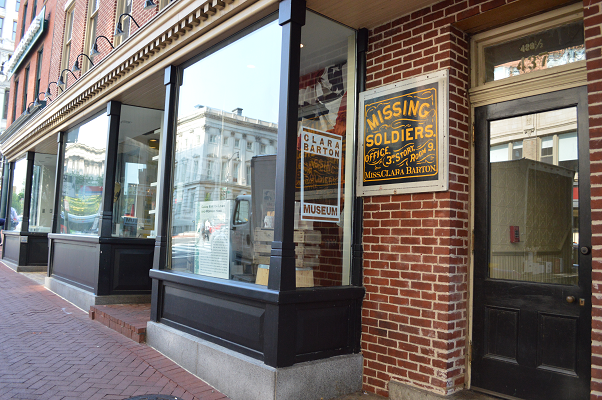
The Conservation of the Clara Barton Building
Post filed in: Historic Preservation Month
The building located at 437-441 Seventh Street, Northwest is a former Pennsylvania Avenue Development Corporation (PADC) owned building which was identified as the office and residence of Miss Clara Barton. The discovery of the building’s history can be credited to a curious and conscientious carpenter for the General Services Administration.
In 1996, a carpenter for the General Services Administration named Richard Lyons was sent to the building to clean it up and to ensure that the space was vacant in preparation for the sale and planned demolition of the building for residential redevelopment Lyons and a coworker worked to prepthe space. The coworker stayed for a time, and then returned to the office. Lyons stayed behind to complete the task because this was the day before Thanksgiving and he did not want to return the following Monday.
As Lyons ascended the darkened stairwell, he heard a noise that led him to a back room. He looked out of a window and witnessed a fender bender and then suddenly felt a tap on his shoulder. He thought it was his coworker that had returned. But when he turned around, out of the corner of his eye, he saw an envelope sticking through the ceiling. He used a nearby ladder to climb through a hole in the ceiling, crawled on his hands and knees and found the sign that read “Missing Soldiers Office.” He investigated further and found clothing, utensils and newspapers from 1859-1868. Lyons packed up the artifacts and hid them. He enthusiastically returned on the following Monday. Lyons was advised by the developer on site not to share the findings with GSA. He decided to visit the Library of Congress to authenticate his discovery by confirming the address. Fortunately, Lyons chose not to take the advice of the developer and not only informed GSA, but went to great lengths, far beyond his call of duty, to save the building from being demolished. His attention to detail and dedication to public service is what kept this landmark from being destroyed.
The building was occupied by Miss Barton from 1861 to 1868 during her work leading the Missing Soldiers Office during and after the Civil War. In 2001, the US Government (GSA) sold the property to JPI, a real estate developer. A preservation easement in perpetuity was added as a provision of the sale. This precedent-setting easement, created by GSA counsel, preserved the second floor where Barton lived and worked, along with first floor space that now serves as a museum, welcome center and related support space. The easement also required that the new owner restore the facade and maintain the building as an historic structure.
Design
A contract between the GSA and Farewell Mills Gatsch Architects, was executed in 2003 for design services to conserve and selectively restore the area acquired under the preservation easement. GSA’s commitment to this project was to stabilize, conserve, and selectively restore the easement spaces. The project’s scope included mechanical, electrical and plumbing, wallpaper conservation, plaster restoration, and stabilization to existing finishes.
This work was done in preparation of a museum build-out which was completed by the National Museum of Civil War Medicine (NMCWM) under an operating agreement between the GSA and NMCWM executed in February 2012.
The original staircase is still intact, so you can literally walk in Clara Barton’s footsteps while running your hand along the original bannister.
The idea behind the restoration was to give the visitor the experience that you are actually in the same room, in the same space at the same time as Clara Barton. Fragments of wallpaper, likely selected by Barton herself, were found behind baseboards and trim. In the attic, a stash of Civil War era wallpapers and patriotic stationary Barton sold to support her battlefield caretaking effort were also found. Original gaslighting components and other surviving artifacts of Barton’s time enabled GSA to faithfully replicate the spaces much as they had appeared during her occupancy. Barton’s attic belongings even included a rare Missing Soldiers list that Clara Barton had produced. The space was not only of historical significance because of the time and the nature of its use, but it is also a testament to the service and commitment of Clara Barton to the missing soldiers. Details like the mail slot she had cut into her door to receive the numerous letters she would receive from around the country inquiring about missing soldiers, and the wall she had put up to divide her room in half to accommodate supplies she collected for soldiers, greatly reducing her own living, are a visible monument to her selfless dedication to her cause.
The Project Team - (r-l) Beth Hannold, Gary Scott (retired NPS NCR Historian—who was a partner in the initial research verifying the discovered artifacts), Chris Hudson-Boyd, Richard Lyons (GSA retired), Sue Stadsklev, former Regional Administrator Julia E. Hudson, Eric Albrecht, Ron Wood, Caroline Alderson, and Beth Savage.
About Clara Barton
Clara Barton was the first female nurse in the Civil War. The bravery she showed during the Civil War was just the beginning. She used her experiences and forward thinking initiatives to mobilize volunteer support to found the American Red Cross and guide the transformation of the International Red Cross to the rapid response humanitarian organization the world depends upon today. Clara Barton was a remarkable woman for her time or anytime. She was a deeply concerned humanitarian who fought for not only women’s rights but for fair treatment in all endeavors.

 U.S. General Services Administration
U.S. General Services Administration
